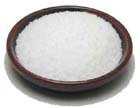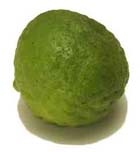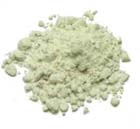|
|
Glossary Selection
Kosher salt | |||
 | Kosher salt (sodium chloride) is the most commonly used salt in commercial kitchens today. Typically kosher salt, unlike common table salt, contains no additives (for example, iodine). Salt is obtained through various methods, mining inland deposits left from prehistoric oceans, or by evaporating sea water. The latter is typically referred to as sea salt, and has a different flavor than mined salt. Kosher salt can be used in nearly all applications, but it is not generally recommended for baking that uses small amounts of liquid (wet ingredients). If there is not enough liquid, the kosher salt will not dissolve sufficiently, and this can result in small bits of salt in the resulting product. In certain applications this is undesirable. | ||
Kalonji | |||
| Nigella sativa is an annual flowering plant, native to southwest Asia. It grows to 20-30 cm tall, with finely divided, linear (but not thread-like) leaves. The flowers are delicate, and usually coloured pale blue and white, with 5-10 petals. The fruit is a large and inflated capsule composed of 3-7 united follicles, each containing numerous seeds. The seed is used as a spice. Kalonji has a pungent bitter taste and a faint smell of strawberries. It is used primarily in candies and liquors. | |||
Kaffir lime | |||
 | Kaffir lime is a small, round, gnarled variety of lime indigenous to Southeast Asia-known as limau perut in Malaysia and makrut in Thailand. | ||
Garlic powder | |||
 | Garlic powder is a spice, or powder, made from pounding garlic. It is often used to top pizza or garlic knots. | ||
Garganelli | |||
 | Garganelli is pasta that is square egg noodle rolled into a tube | ||
Gherkins | |||
| A Gherkin is a young cucumber, picked when 1 to 3 inches (3 to 8 cm) in length and pickled in jars or cans with vinegar (often flavoured with herbs, particularly dill; hence, ‘dill pickle’) or brine. Identical with the French cornichon. A popular condiment. See also Pickled cucumber. | |||
Glutinous rice | |||
| Glutinous rice, also called sticky rice or sweet rice, is the main type of rice grown and consumed by the Lao of Laos and Northeast Thailand, areas which are considered to be the primary center of origin and domestication of Asian rice (Oryza sativa L.). It has been cultivated in this area for 4,000 years. An estimated 85% of Lao rice production is of this type. Despite the misleading name, glutinous rice does not contain dietary gluten (i.e. does not contain glutenin and gliadin), and thus in theory should be safe for gluten-free diets. The word glutinous, meaning glue-like or sticky, comes from the Latin glutinosus. The term glutinous rice refers to rice having no (or negligible amounts of) amylose, and high amounts of amylopectin, the two components of starch. Amylopectin is responsible for the sticky quality of glutinous rice. | |||
Gorgonzola dolcelatte cheese | |||
 | Gorgonzola is a traditional, creamery and co-operative, blue cheese. The greenish-blue penicillin mould imparts a sharp, spicy flavor and provides an excellent contrast to the rich, creamy cheese. Gorgonzola is made in the northern Italian village, according to which the cheese has its name, either from unpasteurized or pasteurized milk to which the mould is added. At about four weeks the cheeses are pierced with thick needles to encourage the spread of the mould. Gorgonzola ripens in three to six months. The cheese is usually wrapped in foil to keep it moist. Its color ranges from white to straw-yellow with an unmistakable marbled green or bluish-green mould. The taste ranges from mild to sharp, depending on age. Gorgonzola is also excellent in salads and dips. | ||
Gooseberries | |||
 | The fruit of the gooseberry is small and round and is connected to the plant with a thin stem. At the calyx (bottom) end of the fruit is the dried, senescent flower. Gooseberries are green in the immature stage, ripening to a deep purple or yellow. The skin may have a striped appearance. | ||
Graham crackers | |||
 | The graham cracker originated in the United States by Rev. Sylvester Graham, a Presbyterian minister, in the early 1800s as a health food. Originally made solely with graham flour, many modern imitation graham crackers contain no graham flour at all, and are based on bleached, refined white flour, which the Rev. Graham implacably opposed. His original Graham bread was the centerpiece of a vegetarian diet created with the intent of suppressing carnal urges, which he believed were the source of many maladies. He also warned that ketchup and mustard caused insanity. He gained many followers, who set up boardinghouses in cities including New York and Boston, where his vegetarian diet was observed. Graham crackers have long since ceased to be considered a health food, but they have remained popular as a snack food. Today, graham crackers are made with much greater amounts of sugar and other sweeteners than used in the original recipe. Cinnamon is also commonly added to graham cracker mix to enhance the flavor. Graham crackers are essential ingredients for various popular snack foods, including moon pies and s'mores, and are often crushed and used as crusts in baking. | ||




